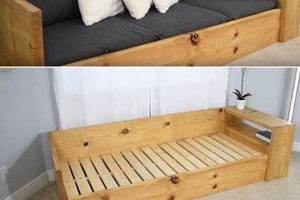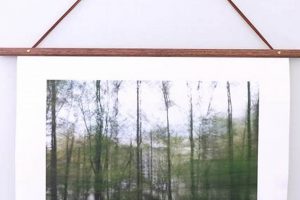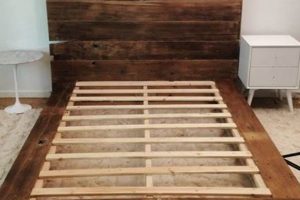A self-constructed support, typically crafted from wood, metal, or repurposed materials, designed to hold and display picture frames, artwork, or signage. These supports offer an alternative to wall mounting, allowing for greater flexibility in placement and presentation within a space. Examples include A-frame easels made from scrap lumber, minimalist metal stands welded together, or even repurposed coat racks adapted to accommodate framed items.
The advantages of creating one’s own display support include cost savings, customization to specific aesthetic preferences and size requirements, and the satisfaction derived from a hands-on project. Historically, handcrafted display solutions were common due to limited access to commercially manufactured options. Even today, customized construction offers a unique opportunity to complement the displayed object and tailor the support to the surrounding environment, increasing visual appeal and creating a more personalized presentation.
The following sections will delve into various design considerations, material choices, construction techniques, and finishing options for creating stable and aesthetically pleasing display solutions for framed items. Attention will be given to ensuring the safety and longevity of both the support and the displayed object.
Construction and Design Considerations
This section offers guidance to ensure both structural integrity and aesthetic appeal are achieved during the construction process.
Tip 1: Prioritize Stability: The base of the support requires sufficient width and weight to prevent tipping, especially with larger frames. Consider incorporating a wider stance or adding weight to the base structure.
Tip 2: Ensure Proper Angle: The angle at which the frame rests significantly impacts visibility. Experiment with different angles prior to final assembly to determine the optimal presentation.
Tip 3: Utilize Appropriate Fasteners: Select screws, nails, or adhesives suitable for the chosen material to ensure a secure and durable connection. Pre-drilling pilot holes can prevent splitting of wood.
Tip 4: Employ Accurate Measurements: Precise measurements are crucial for achieving a level and symmetrical support. Double-check all dimensions before cutting and assembling materials.
Tip 5: Consider Material Compatibility: When combining different materials, ensure they are compatible. For instance, certain wood finishes may react negatively with metal hardware.
Tip 6: Integrate Secure Frame Retention: Implement a system, such as adjustable brackets or recessed ledges, to securely hold the frame and prevent accidental slippage.
Tip 7: Protect Surfaces with Padding: Apply felt pads or rubber bumpers to areas that will contact the floor or frame to prevent scratches and damage.
Adhering to these guidelines results in a stable, functional, and visually pleasing solution for displaying framed items, enhancing the overall presentation.
The subsequent section will provide guidance on selecting the optimal materials for constructing a customized display stand.
1. Material selection
Material selection critically impacts the functionality, longevity, and aesthetic presentation of a do-it-yourself frame support. The chosen material dictates the support’s structural integrity, its susceptibility to environmental factors, and its overall visual appeal. For instance, using untreated softwood for a large frame could lead to structural failure due to insufficient strength and susceptibility to warping. Conversely, employing weather-resistant materials such as treated lumber or metal is crucial for outdoor frame displays to prevent degradation.
The selection process must consider the weight and dimensions of the frame to be supported. Heavy frames necessitate robust materials like hardwood or steel, while lighter frames allow for the use of less substantial materials like plywood or aluminum. Furthermore, the aesthetic qualities of the material should complement the style of the frame and the surrounding environment. A sleek metal frame stand pairs well with modern artwork, while a rustic wooden stand may be more suitable for displaying vintage photographs. Correct material choice also influences joinery methods; welding is suitable for metal, while wood requires techniques like screwing, gluing, or doweling. Choosing materials poorly can result in an unstable support, compromising the presentation and potentially damaging the displayed item.
Ultimately, thoughtful material selection is paramount for creating a safe, durable, and visually harmonious frame stand. The decision process should weigh structural requirements, aesthetic preferences, environmental considerations, and appropriate joinery techniques. A well-chosen material not only ensures the stability and longevity of the frame support but also enhances the overall impact of the displayed artwork or photograph, creating a cohesive and aesthetically pleasing presentation.
2. Structural Stability
Structural stability is a paramount concern in the construction of any self-made frame support. Its importance arises from the need to securely and reliably display framed artwork, photographs, or signage, preventing accidental damage or injury. The following aspects outline critical considerations for ensuring the structural integrity of a stand:
- Base Geometry and Dimensions
The shape and size of the base are fundamental to stability. A wider base provides a lower center of gravity and increased resistance to tipping. Triangular or rectangular bases are common choices, with dimensions scaled appropriately to the size and weight of the frame being supported. Inadequate base dimensions compromise stability, particularly with heavier frames.
- Material Strength and Rigidity
The inherent strength and rigidity of the chosen materials directly influence the support’s ability to withstand loads and resist deformation. Hardwoods, steel, and thick-gauge plastics offer greater resistance to bending and breaking than softer woods or thin plastics. Selecting materials with sufficient load-bearing capacity is crucial for preventing structural failure.
- Joint Integrity and Connection Methods
The points where different components of the frame support are joined together represent potential weak points. Secure and robust connection methods, such as screws, bolts, welds, or strong adhesives, are essential for maintaining structural integrity. Weak or improperly executed joints can lead to instability and eventual collapse. Consider joint type based on forces acting upon the frame.
- Load Distribution and Weight Management
The design should effectively distribute the weight of the frame across the entire structure, minimizing stress concentrations. Even weight distribution prevents localized strain that could lead to material fatigue or failure. Careful consideration of the frame’s center of gravity and strategic placement of support members are key for optimal load distribution.
These factors demonstrate the vital relationship between structural integrity and the functionality of a self-constructed display frame. Addressing each aspect ensures the longevity, safety, and aesthetic value of the display. A failure to adequately address any of these components compromises the presentation and potentially endangers the displayed items.
3. Angle of display
The angle at which a framed object is presented on a self-constructed support directly influences its visibility, aesthetic impact, and the overall viewing experience. The effectiveness of a stand is inextricably linked to the precise inclination it provides. A sub-optimal angle can cause glare, distort perspective, or prevent comfortable viewing, thus negating the purpose of displaying the item. Conversely, a well-chosen angle enhances visual appeal, reduces unwanted reflections, and facilitates optimal interaction with the artwork or photograph. For instance, a shallow angle of display might be ideal for viewing artwork at eye level, while a steeper angle might suit pieces placed below the typical line of sight. The relationship between the display object’s placement and viewing height necessitates careful calculation during the stand’s design and construction.
Consider the practical implications of this connection. A poorly angled frame stand in a retail environment might cause potential customers to overlook featured items. Conversely, a strategically angled display in a museum can guide the visitor’s gaze, enhancing their appreciation of the exhibited artwork. In a home setting, the angle can be adjusted to suit the surrounding furniture and lighting conditions, creating a cohesive and visually pleasing arrangement. The ability to customize the angle is a distinct advantage of a homemade display solution. Adjustable features can be designed to accommodate various display needs, enabling the stand to adapt to different environments or artwork sizes. Mechanisms such as pivoting hinges or adjustable support arms provide the flexibility necessary to fine-tune the presentation.
In summary, understanding and precisely controlling the angle of display are crucial considerations when designing and constructing a frame support. The angle of presentation directly impacts visibility, reduces glare, and enhances the overall aesthetics of the displayed item. The challenges involve accurate calculation, considering viewing distance and light sources, and the integration of features which allow for fine-tuning. The selection of the display angle is more than an aesthetic choice; it is a functional requirement that significantly influences the success of displaying artwork or photographs, highlighting its importance in the crafting process of DIY frame stand.
4. Aesthetic Integration
Aesthetic integration represents the seamless merging of a self-constructed frame support with its surrounding environment and the framed object it displays. The success of a display is not solely determined by functionality but also by how harmoniously it blends into the existing space, complementing rather than detracting from the overall visual experience. Considerations for aesthetic integration significantly enhance the presentation of the art or photograph it supports.
- Material Harmony
The materials used in construction should align with the surrounding decor and the style of the framed object. For instance, a sleek metal stand complements contemporary art, while a rustic wooden stand suits vintage photographs. The choice of material extends beyond aesthetics to encompass considerations of texture, color, and finish, ensuring visual coherence with the environment.
- Form and Proportion
The shape, size, and proportions of the display should be carefully considered to maintain visual balance. An overly large or ornate stand can overwhelm a smaller framed item, while a disproportionately small stand may appear insignificant. The stand’s form should complement the framed object’s shape and size, creating a harmonious and visually pleasing composition.
- Color Palette and Finish
The color and finish of the frame support should either blend seamlessly with the surroundings or provide a subtle contrast that enhances the artwork. Neutral colors like black, white, or gray often serve as effective backgrounds, allowing the framed object to take center stage. The finish, whether matte, glossy, or textured, should complement both the material and the style of the displayed item.
- Contextual Relevance
The design and construction of the frame support should reflect the context in which it will be displayed. A stand for a child’s drawing might incorporate playful shapes and bright colors, while a display for a historical document might utilize more traditional materials and a restrained design. Tailoring the aesthetic to the context increases the visual appeal and enhances the overall impact of the presentation.
Ultimately, successful aesthetic integration transforms a functional frame support into an integral part of the overall display, enhancing the visual appeal of the framed object and creating a cohesive and aesthetically pleasing presentation within its environment. This mindful consideration elevates the design beyond mere utility, making it a considered component within an interior design or exhibition scheme, underscoring the value of a carefully conceived frame support.
5. Frame Security
Frame security, when designing and constructing a self-made picture or artwork support, represents a critical consideration that directly impacts the longevity and integrity of the displayed item. The structural integrity of the stand itself is insufficient; securing the frame to the support prevents accidental falls, theft, or damage from environmental factors.
- Retention Mechanisms
Retention mechanisms are physical components designed to hold the frame in place on the stand. These may include ledges, brackets, clips, or adjustable fasteners. The selection of the appropriate mechanism depends on the frame’s size, weight, and material. For instance, a heavy frame might require robust metal brackets, while a lightweight frame could be secured with clips. Incorrectly sized or poorly installed mechanisms compromise frame security, increasing the risk of accidental slippage or detachment.
- Material Compatibility and Friction
The materials used in the retention mechanism must be compatible with the frame’s surface to prevent scratches or damage. Soft materials like felt or rubber can be used as padding to create a protective barrier. Friction plays a crucial role in maintaining the frame’s position. Non-slip surfaces or coatings can enhance friction, preventing movement even under slight vibrations or impacts. Lack of friction contributes to instability and potential falls.
- Security Hardware Integration
In environments where theft is a concern, security hardware can be integrated into the frame stand design. This may include locking mechanisms that secure the frame to the stand or tethers that prevent unauthorized removal. The complexity and effectiveness of the security hardware should be proportionate to the value of the displayed item and the level of risk. The absence of such security can increase theft risks.
- Environmental Considerations
Frame security also involves protecting the frame from environmental factors such as wind, humidity, and temperature fluctuations. Outdoor frame stands require features like wind-resistant designs or protective covers. Indoor stands should be positioned away from direct sunlight or sources of moisture. Failure to account for environmental factors can lead to gradual deterioration of the frame and its contents.
These components highlight the complex relationship between frame security and the do-it-yourself construction process. Secure retention, compatible materials, integrated hardware and environmental consideration are all key elements within the design of a bespoke frame stand to ensure the long term condition and safety of the display piece.
Frequently Asked Questions
This section addresses common inquiries regarding the design, construction, and implementation of self-made frame supports. The information provided aims to clarify technical aspects and offer practical guidance for successful project completion.
Question 1: What constitutes a suitable base size for a frame support intended for a large, heavy painting?
The base size should be proportionate to the dimensions and weight of the frame. A wider base provides greater stability. The base’s footprint should ideally equal or exceed 50% of the frame’s height to mitigate tipping risks. Material selection should align with anticipated load stress.
Question 2: Which materials are most effective in resisting warping or deformation in outdoor frame supports?
Pressure-treated lumber, aluminum, and stainless steel offer superior resistance to moisture, temperature fluctuations, and UV exposure. These materials minimize warping, corrosion, and structural degradation, ensuring the longevity of the support in outdoor environments.
Question 3: What joinery techniques provide the strongest and most durable connections in wooden frame supports?
Mortise-and-tenon joints, dovetail joints, and reinforced screw connections offer exceptional strength and resistance to stress. Adhesives compatible with the wood type further enhance joint integrity. Proper alignment and clamping during assembly are essential for optimal results.
Question 4: How can the angle of the displayed frame be adjusted after the initial construction of the support?
Adjustable hinges, ratcheting mechanisms, and sliding supports enable post-construction angle adjustments. These features provide flexibility in accommodating various viewing heights and lighting conditions. Secure locking mechanisms prevent unwanted angle shifts.
Question 5: What safety precautions should be observed during the construction of a frame support involving power tools?
Appropriate personal protective equipment (PPE), including eye protection, hearing protection, and gloves, is mandatory. Power tools should be operated according to manufacturer instructions. The work area should be well-lit and free of obstructions. Ensure all safety guards are in place and functional prior to operation.
Question 6: How can the frame be securely attached to the support to prevent accidental falls or theft?
Ledges, brackets, and locking mechanisms provide secure attachment points. Security screws, tamper-resistant fasteners, and tethers can further deter theft. The attachment method should be appropriate for the frame’s weight and material. Periodic inspection of attachment points is recommended to ensure continued security.
The answers furnished offer pragmatic advice to guide DIY enthusiasts and professionals in constructing secure, durable, and aesthetically pleasing frame stands. The information underscores the importance of material selection, joinery techniques, and safety protocols in achieving successful outcomes.
The subsequent section will provide detailed step-by-step instructions for constructing a basic, yet functional, frame support using readily available materials.
Conclusion
This exploration of “diy frame stand” construction has elucidated key elements impacting functionality, aesthetics, and security. Emphasis has been placed on material selection, structural integrity, display angle, aesthetic harmony, and frame retention methods. Understanding these principles is vital for achieving satisfactory results in self-constructed display solutions. Adherence to established guidelines promotes safety, durability, and the preservation of displayed items.
The creation of a support serves as a practical exercise in resourcefulness, offering tailored solutions not readily available commercially. Continued refinement of these techniques, combined with innovative design approaches, will likely yield enhanced functionality and aesthetic integration within diverse environments. Mastery of this skill provides tangible benefits to both personal and professional presentation endeavors. As such, continued education within this craft is encouraged.







